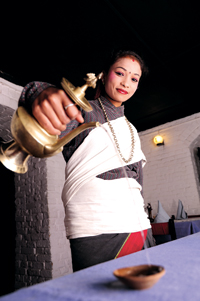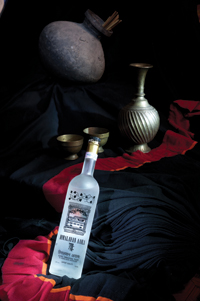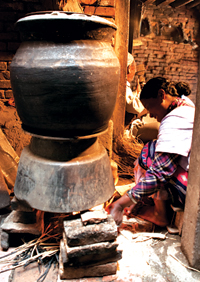The strong Nepali liquor is now making its ways into a more international palate.
It is part of every religious occasion, it is believed to have healing powers, it is jokingly dubbed ‘Wasa’ (meaning medicine in Newari) for being an excellent remedy for stomach aches and the annoying flu… and lets see what else – ah yes, cold winters and for well, hangovers. And it goes superbly with Newari food.
 Skipping teetotallers, if you don’t know what I’m talking about then you’ve been missing something. It could also mean that you haven’t been in Kathmandu long enough or that you’ve skipped the title which would induce one to assume you’ve been drinking… was it Aaila?
Skipping teetotallers, if you don’t know what I’m talking about then you’ve been missing something. It could also mean that you haven’t been in Kathmandu long enough or that you’ve skipped the title which would induce one to assume you’ve been drinking… was it Aaila?
Aaila. A drink symbolizing purity offered even to gods and goddesses. A drink so potent just a shot or two would knock you out - unless you’re used to it of course. Old, yet truly unknown and unrecognized - the Newari word for Rakshi (rakshi being the Nepali word for alcohol) also commonly referred to as ‘local’ – aaila.
Let’s dispel a ridiculous preconception first. Fine restaurants serve imported therefore expensive spirits while aaila is the cheap stuff one would find in a bhatti. The taste buds of people who follow this notion have missed two wonders – amazing Newari food and of course aaila. Did I mention how well these two go together? I did but it is worth mentioning again. For those that favour the expensive whiskies in fine restaurants - your ideal side is haggis. (Do your homework and you’ll find out it’s not very different from the delicacies available in Newari foods.)
Its potency might be behind this sad little fact. The strength and weakness of aela lies in its alcoholic content (measured in percentage or proof anything over 100 proof equivalent to 57% is called overproof and aaila is always overproof. In fact, a test of its quality is in seeing it light up either by throwing it in the fire or on the tip of one’s finger.
 This is one known face of aaila – strong and (thankfully) cheap liquor. The real story of aaila however goes beyond the commercial versions you find in bhattis and is deeply rooted in Newari culture and tradition. The making of aaila which is said to have first started, to use rice that would go to waste after each harvest is today not only a cherished practice but has evolved into an art form, practised mostly within Newar families and communities.
This is one known face of aaila – strong and (thankfully) cheap liquor. The real story of aaila however goes beyond the commercial versions you find in bhattis and is deeply rooted in Newari culture and tradition. The making of aaila which is said to have first started, to use rice that would go to waste after each harvest is today not only a cherished practice but has evolved into an art form, practised mostly within Newar families and communities.
And yet this form of art remains relatively unknown, and the extent of its brilliance even further so because it is not exhibited commercially. It is made, consumed and celebrated within communities.
The taste of any spirit is a careful outcome of its components, the methods followed in its making and the skill of the people making it. The same is true for aaila and its making is every bit as elaborate and diverse as the making of well known spirits like fine scotch with one exception – aaila is not aged – technically not aged. Older aailas are considered better but it can be assumed that the effects are similar to that of aging wines in bottles as opposed to aging in wooden casks where the wines and spirits breathe and take in flavour from the air. Decades old aged aailas are actually not uncommon –stored by families for occasions like weddings. The problem though is these are not available for sale. While old whiskies and brandies are rare and expensive and available to those with a lot of money, old aailas are rare and unavailable – except to those who already have it or have great friends.
 Aaila is unique and incredibly diverse. Made from rice, it bears some semblance to the Japanese sake but the methods of making it render the similarities void. It is often made from millet or a mixture of the two and taking this and the production methods into account, aailas differ from each family that makes it just like different brands of the same spirit.
Aaila is unique and incredibly diverse. Made from rice, it bears some semblance to the Japanese sake but the methods of making it render the similarities void. It is often made from millet or a mixture of the two and taking this and the production methods into account, aailas differ from each family that makes it just like different brands of the same spirit.
Ask around and I guarantee you’ll find some amazing ones. I still remember this particular one from somewhere in Basantapur – it had the freshness of gin and the smoothness of a fine scotch. Take my word for it - I’ve sampled my share of good alcohol and that aaila was nothing short of amazing. And then there was that bottle of aged aaila a friend of mine brought a long time ago in college – if only my taste buds had matured enough to appreciate it, then.
While the Italians are credited for liqueurs, those who make aaila deserve fair credit for flavoured aailas. Fruits, flowers, and even nuts are used to flavour aaila. To give you an idea, there are aailas made from apples, grapes, bananas, oranges, roses, marigold, jasmine, walnuts and even betel (Paan).
Aela is underrated, underappreciated, unknown – and the best part - awaiting discovery.










